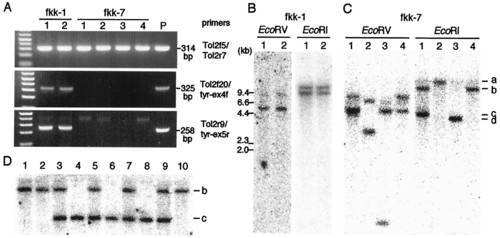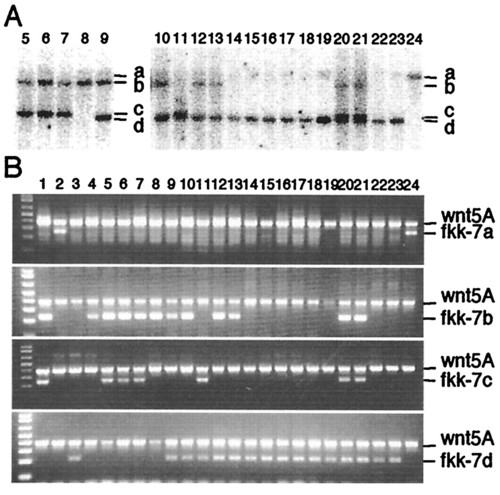- Title
-
Identification of a functional transposase of the Tol2 element, an Ac-like element from the Japanese medaka fish, and its transposition in the zebrafish germ lineage
- Authors
- Kawakami, K., Shima, A., and Kawakami, N.
- Source
- Full text @ Proc. Natl. Acad. Sci. USA
|
PCR and Southern hybridization analyses of F1 fish. (A) PCR analyses of genomic DNA extracted from caudal fin clippings of F1 fish from fkk-1 and fkk-7. Primer pairs used for PCR and the sizes of the PCR products are shown on the right. Two (fkk-1, lanes 1 and 2) and 25 F1 fish were found positive for PCR using Tol2f5/Tol2r7 out of 68 and 50 F1 fish from fkk-1 and fkk-7, respectively. PCR analyses of the 25 F1 fish from fkk-7 yielded the same results, and four representatives are shown (fkk-7, lanes 1-4). The same four samples were used also for Southern hybridization (described in C). In the control (P), 100 ng of zebrafish genomic DNA plus 1 pg of the (Tol2-tyr)ΔRV plasmid DNA were used as a PCR template. (B) Southern hybridization analysis of F1 fish from fkk-1. DNA samples of two fish (A) were digested with either EcoRV or EcoRI and hybridized with the probe shown in Fig. 1. (C) Southern hybridization analysis of F1 fish from fkk-7. DNA samples of four fish (A) were digested with either EcoRV or EcoRI and hybridized with the probe (Fig. 1). EcoRI bands of four different sizes, shown as a-d on the right, correspond to the fkk-7a, fkk-7b, fkk-7c, and fkk-7d insertions described in the text. The lower bands in EcoRV lane 1 are probably a triplet. (D) Southern hybridization analysis of F2 fish from the lane 1 F1 fish (fkk-7). Ten fish out of 14 F2 fish, which were positive for PCR using Tol2f5 and Tol2r7, were analyzed. DNA samples were digested with EcoRI and hybridized with the probe (Fig. 1). Fish with fkk-7b alone (lanes 1, 2, 10), fkk-7b alone (lanes 4, 6, 8), and both fkk-7b and fkk-7c (lanes 3, 5, 7, 9) were identified. |
|
Identification of the Tol2 insertions in F1 fish. (A) Southern hybridization analysis of F1 fish from fkk-7. DNA samples from 20 F1 fish were digested with EcoRI and hybridized with the probe (Fig. 1). The numbering of the lanes (fish) is continued from Fig.2 C. Bands of four different sizes, a (lane 24), b (lanes 5-10, 12, 13, 20, 21), c (lanes 5-7, 11, 20, 21), and d (lanes 9-23), were detected. The lower bands on lanes 11, 20, and 21 are doublets. (B) PCR analysis of 24 F1 fish from fkk-7. DNA samples on lanes 1-4 correspond to those on lanes 1-4 of Fig. 2C. PCR reactions were carried out using the wnt5A primers (positive control) and 7a3′ and Tol2f20 (fkk-7a), 7b5′ and Tol2r1 (fkk-7b), 7c3′ and Tol2f20 (fkk-7c), or 7d5′-2 and Tol2r1 (fkk-7d). On these photos, the presence of the lower band indicates that the fish carries the specific Tol2 insertion. The results are consistent with those obtained by Southern hybridization analysis and are summarized in Table 1. |


